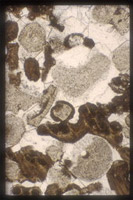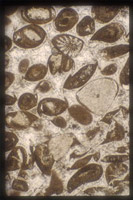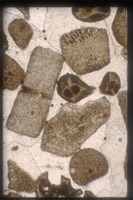Limestone Thin Sections:
Illustration No. 1 (Sample CM-3) is a photograph of a highly thinned piece of limestone viewed under the magnification of a polarizing microscope. The small sample of stone was thinned by grinding and polishing after having been cemented to a glass slide. A “thin-section” it is called and it is a standard means for studying the composition of stone.
This piece of limestone came from the Confederate Monument in Montgomery, Alabama—a subject of our study in the production of a Historic Structures Report for the state. This project is given broader attention elsewhere in this website.
This sample of limestone, CM-3, was taken from the upper portion of the monument. It was quite apparent that the limestone on the upper half of the Confederate Monument had a different appearance from the limestone used to construct the lower half. A large part of this difference in appearance had to do with the lower limestone supporting a black biological growth while the upper stone was almost entirely free from this blight.
The historical record simply indicated that the limestone came from the early (about 1886) and still-producing quarry in the northwestern corner of Alabama—Rockwood, near Russellville, in Franklin County. The question of why the stone in the upper monument was so different was investigated.
If the limestone in the upper section was different, it may have come from the next major quarrying region, around Bedford Indiana. This was a supposition in the investigation by the McKay Lodge, Inc. monument research team. However, if this proved true, it would be quite an interesting addition to our historical knowledge of the monument. Since the monument was created to commemorate the patriotism of those who fought for the Confederacy, one would assume that every effort would have been made to only use stone from states that banded together in the Confederacy to protect state’s rights. The quarry in Alabama produced then, in the 19th century, and is still producing today, the finest of limestone. Why turn elsewhere for stone? While we have yet to fathom an answer to this question our study does suggest that the monument was begun with local stone, then completed with stone having the characteristics of Indiana limestone.
In an attempt to determine if the limestone in the upper half of the monument was sourced in Indiana, microscopic studies were made of both the upper limestone and the lower limestone and compared with samples from the Alabama and Indiana quarries. In these studies, the most characteristic factors were sought for each source. These differing characteristics lay primarily in crystallization of calcite and inclusion of fossils. This study was not exhaustive; rather, it was sufficient to encourage a more sustained and focused investigation if it should be found that the historical record requires a definitive opinion on the source of the stone used in the upper monument.
The limestone quarried in both Indiana and Alabama are part of a blanket of sediments deposited across much of the central United States during the geological time period known as the Mississippian. The Mississippian lasted from about 360 to 320 million years ago, which is about 75 million years before the dinosaurs evolved (dinosaurs have been extinct now for 65 million years).
During the Mississippian, the North American continent lay astride the equator thanks to continental drift. Much of the central part of the continent was covered by vast seas that were warm and shallow and very similar to those found in tropical places like the Florida Keys and Bahamas of today. Like those regions, the Mississippian seafloor was carpeted by a multitude of different organisms that produced shells and other hard parts made of the chemical compound CaCO3 (calcium carbonate). As the organisms lived and died, their shells slowly accumulated over the millions of years and as they were buried ever deeper by other sediments, they were eventually converted from loose sediments into the type of sedimentary rock known as limestone.
The exact composition of the sediments on the Mississippian seafloor varied from place to place depending on what organisms lived there and what the environmental conditions such as waves, tides and storms were. However, much of the sea floor consisted of shoals of well-sorted “sands” derived from the shells and such. When they are converted to rock, these types of “sands” form a variety of limestone known as calcarenite. Calcarenites are the rocks that are most commonly quarried for building stone in Indiana, because they are fairly uniform and quite strong.
When they are first deposited on the seafloor, any well-sorted sand is like a jar of marbles in that the weight of each sand grain must be supported by tiny points of contact with adjacent and underlying grains. Therefore about 50% (i.e. half) of any given volume of well-sorted sand originally consists of water-filled pores rather than solid crystalline matter. The quarried limestone formed from these sands has a porosity that is much less than 50% of its total volume, so most of the original pores have disappeared since the sand was originally deposited. The elimination of porosity is nature¹s way of turning loose sediment into hard rock, and there are basically two ways to do it. One way is known as compaction: as sediments slowly pile up over the eons, the immense weight of the overburden slowly crushes and squeezes the sand grains at the bottom of the pile closer and closer together, so the pores get smaller and smaller. The second way is known as cementation: instead of the pores getting crushed out of existence, crystals grow from groundwater as it slowly moves through the pores, so the pores get filled up like miniature geodes until there is little or no open space left. In practice, both compaction and cementation are typically involved in converting a loose sediment into hard rock. This general process is known as lithification and it normally takes millions and millions of years to complete. Crystals that grow in the pores of sediments are known to geologists as “cements.”
All of the Mississippian limestone sampled from the Alabama Confederate Monument, as well as most of the limestone found in Indiana, are calcarenites. They are all similar in a general way in that they all originally consisted of well sorted sand and show textural evidence of cementation. However, they vary in terms of (1) the abundances of different types of fossils, (2) the amount of compaction they show, and (3) the textures of the cements they contain.
More specifically, a close look at the samples taken from the base, or lower section, of the Confederate Monument in comparison with the upper section limestone of the Confederate Monument with a polarizing microscope reveals a clear difference between these two rocks in terms of both fossils and cement.
The samples from the upper part of the Confederate Monument (e.g. sample CM-3 illustrated above) have a fair abundance of sand grains derived from crinoids, which are known informally as “sea lilies.”
Crinoids were animals whose living relatives include sand dollars and sea urchins, and one thing these organisms all have in common is that they make their “shells” out of an interlocking mosaic of large crystals. The shapes of these crystals vary quite a bit; some are shaped like checkers or millstones, others are V-shaped or more irregular. Although they vary in shape, the fact that they are large single crystals sets them apart; the shells of other types of organisms are always made of finer crystals.
Under the microscope, these large crystals are easy to spot because they appear as large patches that are relatively clear except for dusty inclusions, whereas the shell crystals of other types of organisms such as corals, clams, and bryozoans are quite dark by comparison. The large crinoid crystals are common in samples of Indiana limestone. In contrast, crinoids are relatively scarce in the calcarenite sample from the base of the Confederate Monument Illustration No. 2 (sample CM-1) known to be Alabama limestone whereas, here, other types of fossils are more abundant.
This difference in the relative abundance and size of the fossils in these two illustrated calcarenites also had a big influence on the type and abundance of cement they contain. When cement crystals start growing from scratch, they typically form as tiny crystals so that many are present in each pore and the crystals bump into one another before they get a chance to grow very large. However, when a large crystal like a crinoid is already present, new material can be added directly on to it (like adding legos onto a basal template instead of trying to organize them individually on a rug), so any crystals that were large to begin with get even larger. In limestone, crinoids are the only type of grain that can provide large seeds to serve as templates for cement crystals to grow on, so the pores in calcarenites rich in crinoid particles tend to get filled with large, clean crystals of calcite instead of tiny crystals resembling mini-geodes. This effect is clearly evident in the samples form the Confederate Monument. The samples from the upper part of the Confederate Monument (e.g., CM-3) with abundant crinoid grains have cement crystals that are much larger and clearer than those filling the pores of the crinoid-poor calcarenite from the base of the Confederate Monument (CM-1) in which other types of fossils are much more abundant.
The same correlation between an abundance of crinoid grains and large cement crystals is also evident in the calcarenite samples from the quarries of Indiana. Like the samples from the upper section of the Confederate Monument, (see Illustration No. 1 (CM-3)), a calcarenite sample taken from Indiana Illustration No. 3 (IN-11) is rich in pieces of crinoid fossils and therefore has large clear cement crystals filling the spaces where the pores used to be. The sediment looks a little different because the sand grains in sample IN-11 were slightly larger than those in CM-3, but the basic textural elements are very similar.
In contrast to Indiana limestone illustrated in sample IN-11 , crinoid pieces are rather scarce in the calcarenite from a sample of stone at the Russellville quarry IIlustration No. 4 (CM-4), so like the sample illustrated previously from the base of the Confederate Monument (CM-1), the former pores in Russellville sourced limestone are filled largely with tiny crystals of calcite instead of big clean crystals.
In summary, a preliminary examination of the textures of the calcarenites support the suggestion that the limestone sampled in the upper section of the Confederate Monument came from Indiana limestone whereas those at the base came from Alabama limestone.
A note of caution is necessary. Sediments are by their nature very heterogeneous, so the textural match between samples from the base and upper section of the Confederate Monument with limestones collected in Alabama and Indiana respectively does not prove beyond a doubt that the upper blocks were quarried in Indiana. The strata in the Russellville quarry are probably somewhat heterogeneous, and so it is possible that there could be a layer there with textures like those in the upper blocks of the Confederate Monument. Since the layers in the limestone of both Indiana and Alabama are relatively flat and undisturbed, so this could probably be determined fairly easily by sampling the layers exposed in the quarry. However, if the samples available are representative of all of the layers in the quarry, it would seem that the calcarenites in the upper section of the Confederate Monument are a much better match for stone from Indiana than for stone from the Russellville Alabama quarry based on the textures they show under the microscope.




